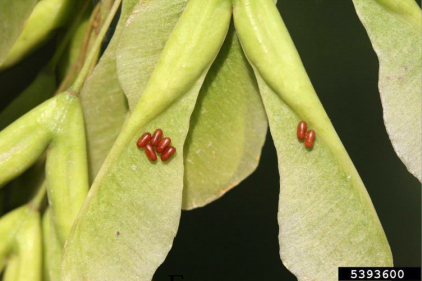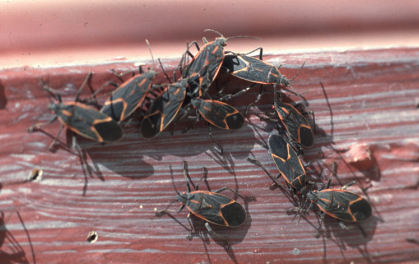Boisea trivittata
Author: Integrated Pest Management Program, University of Georgia, 2020
Description
Immature stages: Boxelder bug eggs are red/orange, and are most often found on the leaves, and cracks and crevices in the bark of female boxelder and silver maple trees. Immature bugs are wingless, bright red and black.
Adult stages: Adults are 1/2 to 5/8 inches with red eyes. Their bodies are black with three red-orange stripes on the thorax, a line along each side, and a line on each wing.


Biology
Life Cycle: Eggs are usually laid on the bark of female boxelder or silver maple trees, among others. The nymphs, which begin to hatch around June, have sucking mouthparts with which they extract juices from trees. Boxelder bugs feed and grow until midsummer when they develop into adults and lay eggs for the second brood. Although large numbers of boxelder bugs can sometimes be observed on host plants, their feeding causes no obvious damage to trees. When fall temperatures begin to drop, adults search for protected places to overwinter, such as houses and other buildings, in cracks or crevices in walls, doors, under windows and around foundations. They tend to gather on south and west exposures.
Damage
Boxelder bugs are primarily a nuisance pest, annoying residents by crawling on exteriors and inside dwellings on warm fall and winter days. They also may stain draperies and other light-colored surfaces and produce an unpleasant odor when crushed. They do not reproduce during this period.
They may attempt to feed on house plants, but they do not cause any damage. They are not dangerous, and have only been reported to bite humans on rare occasions.
Management
If only one or two trees of no particular value seem to be the source of boxelder bug problems, their removal might prove best for longterm boxelder bug control. However, keep in mind that these bugs can fly in from elsewhere in a neighborhood. Wholesale cutting of boxelder bug infested trees is not recommended. When bugs begin to congregate on building exteriors, these areas may be sprayed with residual insecticides. It is important to ensure window and door screens are intact and that doorsweeps are installed properly. If bugs get inside, the best solution is to vacuum them up quickly. When they die inside walls or in attics, their carcasses can accumulate and attract other insects that eat them, especially carpet beetles.
